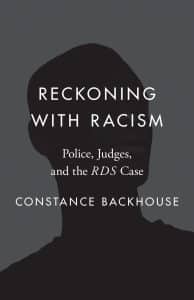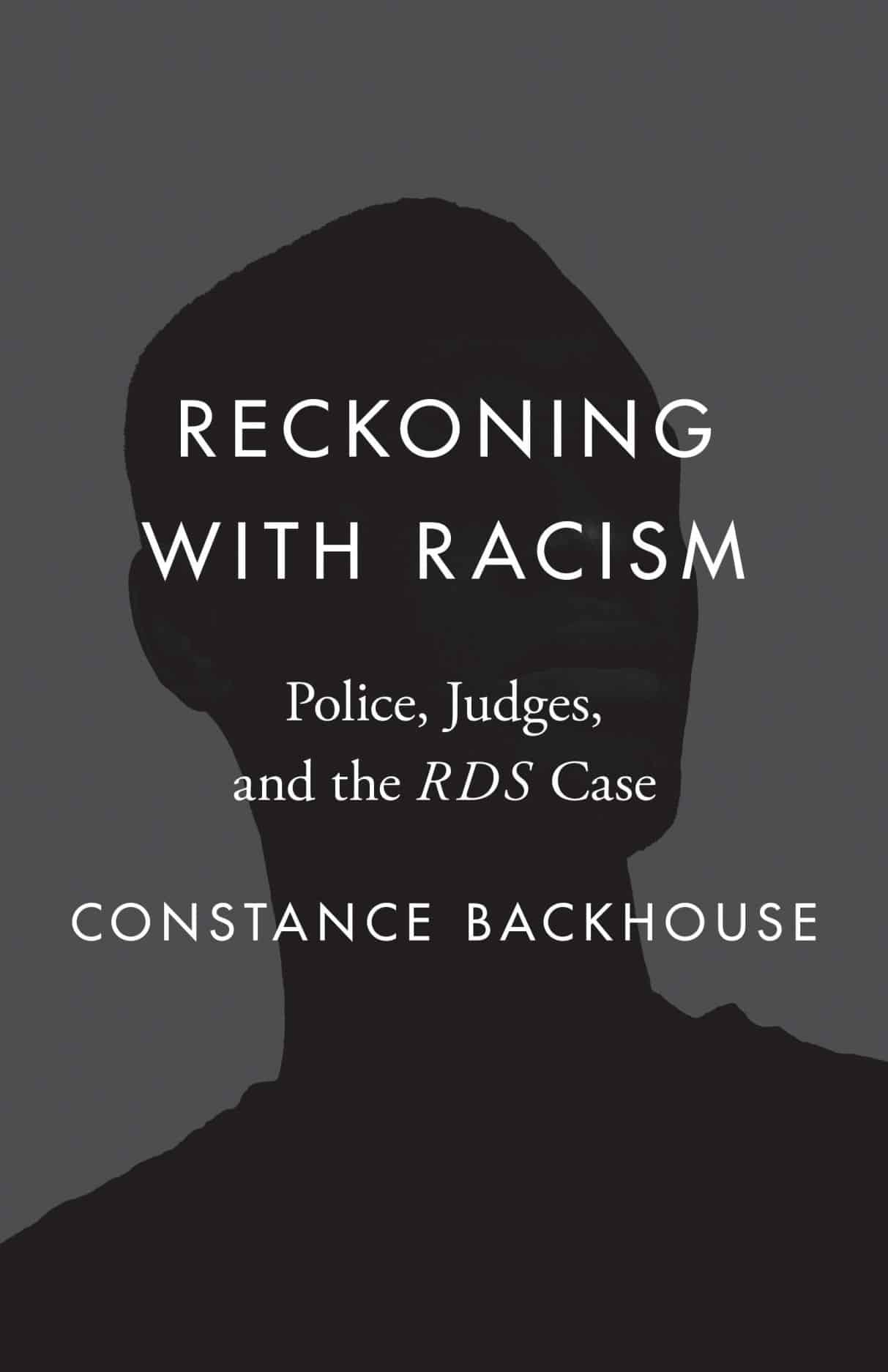 Constance Backhouse, a prominent Canadian legal historian and scholar, delves into the role racism plays in the justice system in her latest book, Reckoning with Racism: Police, Judges, and the RDS Case. RDS was the case of Rodney Smalls, a Canadian teenager charged with assault and obstruction after an incident with police. What is remarkable about this case is just how unremarkable it should have been. Instead of simply making its way through the system, the case turned into a nation-wide analysis on Black racism in Canada’s legal system.
Constance Backhouse, a prominent Canadian legal historian and scholar, delves into the role racism plays in the justice system in her latest book, Reckoning with Racism: Police, Judges, and the RDS Case. RDS was the case of Rodney Smalls, a Canadian teenager charged with assault and obstruction after an incident with police. What is remarkable about this case is just how unremarkable it should have been. Instead of simply making its way through the system, the case turned into a nation-wide analysis on Black racism in Canada’s legal system.
On October 17, 1993, Rodney Smalls was a fifteen-year old boy riding his bike home in his predominately Black neighbourhood in Halifax, Nova Scotia. He happened upon his cousin who was being arrested by Constable Donald Stienburg. Rodney called out to his cousin asking if he was alright. Constable Stienburg told Rodney to “shut up” or he would also be arrested. Rodney told to his cousin that he would get the arrested boy’s mother. At this point, the officer placed both teenagers in chokeholds and the younger Rodney was charged with assaulting a police officer, assaulting a police officer with intent to prevent a lawful arrest of another person, and obstruction of a police officer.
The trial began on December 2, 1994, in the Youth Justice Court in Halifax in front of Judge Corrine E. Sparks, Canada’s first Black judge. According to Backhouse, “the courtroom gathering was unprecedented” (pg. 12), with a majority of court personal being Black, including Judge Sparks, Rodney Smalls, his defence lawyer, Burnley “Rocky” Jones, as well as the deputy sheriff and the court reporter. The only white people involved in the case were Constable Stienburg and Crown prosecutor, Richard B. Miller.
You would be forgiven for thinking that this sounded like a run-of-the-mill case. There were only two witnesses called: Rodney Smalls and Constable Stienburg. Their respective recollections of the events on the night in question differed. The arresting officer alleged that Rodney was both verbally and physically aggressive. Rodney claimed he was simply a “nosey” teenager inquiring about his cousin’s arrest, and wanting to get him adult support. After listening to the testimony of both witnesses, Judge Sparks handed down her oral decision that dismissed all charges against Rodney. It was while considering the credibility of both witness when Judge Sparks stated:
I’m not saying that the Constable has mislead the Court, although police officers have been known to do that in the past. I am not saying that office overreacted, but certainly police officers do overreact, particularly when they are dealing with non-white groups. That to me, indicates a state of mind right there that is questionable (pg. 21-22).
It was those words, according to Backhouse, that sparked a controversy that would capture the attention of Canadians and would take the question of race relations between police and minority groups all the way to the Supreme Court of Canada.
It is necessary to place this seemingly innocuous case into the wider historical context of race relations in Canada, and in particular, in the justice system. The author, over three chapters, discusses the people directly involved at the initial trial in Nova Scotia in great detail. She provides an in-depth description of the backgrounds of the key people involved, and attempts to show how their disparate upbringing and life experiences affected each person who entered the courtroom that December morning.
Backhouse spends one chapter exploring Black history in Nova Scotia. Although the province had a large, if unknown, history of slavery in the seventeenth and eighteenth centuries, “by the late eighteenth century,” she writes, “the province could count itself home to the largest free African population outside Africa” (pg. 40-41). However, racial discrimination and Black resistance was a part of Nova Scotian life up to the incident in question. In fact, while reading her chapter on Black history in the province, there are surprising comparisons to violence against Black communities, segregation laws, and the civil right movements that most Canadian associate with our neighbours south of the thirty-ninth parallel.
This leads directly into her chapter on race and policing in Nova Scotia. Backhouse describes a history of discrimination, violence, and over-charging the Black community to illustrate that the Rodney Smalls incident did not occur in a vacuum. She is careful not to label individual officers as racist, but rather illustrates a system of racist behaviour ingrained over years. There was a deeply fractured relationship between the police and the Black communities they were there to serve. What is most interesting about this analysis is the indignation and backlash from those in positions of authority – the government and the police – to the notion of racism or racial bias even existing in Nova Scotia.
The author has done an excellent job combining history, sociology, cultural anthropology, economics, and politics to provide the reader with a context for the legal analysis that she considers for the rest of her book. Moreover, many of the issues she discussed in these chapters become pivotal as the case wound its way to the Supreme Court of Canada.
‘Innocent until proven guilty’. For much of the public, the accused is always guilty. If they were innocent, why would the police arrest them? Why would the Crown lay charges? Why would it go to trial instead of seeking a plea? Mainly because it is the Crown’s duty to prove guilt beyond a reasonable doubt. The words ‘beyond a reasonable doubt’ are significant and often overlooked or misunderstood. Credibility of a witness is an issue for the judge or jury to consider. This is particularly difficult in cases with contradictory testimony, such as the Rodney Smalls case.
Judge Sparks dismissed the case because she determined that Rodney Smalls was more credible than Constable Stienburg. This was not at issue. As Backhouse argues, “it was her comments about police officers overreacting with non-white groups and the “prevalent attitude of the day” that caused the uproar” (pg. 66). Although the case had suddenly become about judicial bias against the police, race would remain a central issue throughout the appeals process.
Backhouse also suggests that gender featured prominently in the Rodney Smalls case. At the time of her appointment in 1987, Judges Sparks was one among a few women on the bench across Canada. Demographics largely tell the story here. While this was changing, the process was slow. Only with time and a shift in the demographics of the legal profession would diversity come to the bench. In those early years as women were being appointed to the bench, they faced sexism from lawyers and their judicial colleagues. Backhouse writes “[s]tereotypes cast women judges as weak, emotional, illogical, manipulative, incapable of exercising authority, and lacking in objectivity” (pg. 116). From the initial complaint in this case through appeals process at the Nova Scotia Supreme Court and Court of Appeal to the Supreme Court of Canada, there were only three female judges out of fifteen judges who ruled on Judges Sparks’ reasonable apprehension of bias.
The interest in this case grabbed the attention of a number of interveners, including the Women’s Legal Education and Action Fund (LEAF) and the National Organization of Immigrants and Visible Minority Women of Canada (NOIVMWC). Notwithstanding the importance of the case for Rodney Smalls, the wider implications for women and minority women was of significant national consequence.
It was clear how the defence and the Crown would present their arguments to the Court. For Backhouse, it was the top Court’s response that was arguably surprising. She writes, “[t]he sixty-four-page decision – four judgments from nine judges – was sufficiently tangled to baffle most readers” (pg. 141). Explaining this judgment was a monumental task that the author accomplishes over two chapters. However, it was not only the twisted path to Rodney Small’s acquittal, but also the nature in which the oral arguments were handled by the nine white judges, seven of whom were male.
Backhouse makes excellent use of the appeal transcript to analyze many ‘racially problematic’ comments made by Chief Justice Antonio Lamar. She shows how Chief Justice Lamar kept interrupting the defence’s oral arguments with some racially charged comments and questions about the Chinese and Roma populations. Complaints were lodged with the Canadian Judicial Council who dismissed the grievance arguing that Lamar’s comments were hypothetical and made in an attempt to contextualize how the issue of race was not evident. Ironically, his generalities about race and racial stereotypes were strikingly similar to those used by Judges Sparks, who was accused of judicial bias.
The dissent, penned by Justice John (Jack) Major, asserted that there was no evidence of racial bias by Constable Stienburg, and that Judge Sparks comments were over the line. They ruled the acquittal should be quashed and returned to Halifax for retrial. The majority judgement, led by Justice Claire L’Heureux-Dubé and Justice Beverley McLauglin, tackled the issues of impartiality, bias, objectivity, and racism. They did not agree with their colleagues that evidence of racism was absent in this case. On the contrary, they found Judge Sparks’ ruling was informed by history and context. The majority ruled that the acquittal stand.
Arguably, nobody who walked into that Halifax courtroom on December 2, 1994, believed that what should have been a routine case in Youth Court would reach the Supreme Court of Canada and have national implications for racism in the legal system, judicial bias, or a reasonable apprehension of bias. Though, as Backhouse suggests in her conclusion, this case was about policing and the disproportionate response to an arrest involving two Black youths, it quickly turned in to query on systemic racism within the justice system. This book is extensively researched and well written. It is an invaluable source for historians, legal scholars, sociologists, racial theorists, and any person interested in race and legal history.



